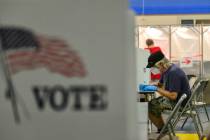We shouldn’t need a booklet for things like this
Is the world really a more dangerous place?
Or has coverage of incidents such as the Aurora, Colo., movie-theater shooting; the Gabby Giffords shooting in Tucson, Ariz.; the Utoya island camp shootings in Norway; the Ford Hood shootings in Texas; the Virginia Tech shooting; the Columbine shooting; the Luby's Cafeteria shooting in Killeen, Texas; the Stockton, Calif., schoolyard shooting; and the San Ysidro, Calif., McDonald's shooting just made it seem more dangerous?
Perhaps both?
In 2008, the Department of Homeland Security in conjunction with the National Tactical Officers Association, the Fairfax County, Va. Police Department, the National Retail Federation and the Retail Industry Leaders Association put together a booklet titled, "Active Shooter: How to Respond." It's getting some renewed attention in the wake of the Aurora tragedy.
The fact there's an actual booklet that you can download from the Internet on how to survive a mass shooting is, in itself, disturbing. These incidents have become common enough for the government to pass out informational literature, as if we're combating a natural disaster or the outbreak of a disease?
Not that the suggestions are bad; there's some good advice to be found there, some the kind your local police department would dispense on how not to get mugged in the average mall parking lot, such as "be aware of your environment and any possible dangers." It adds that people should "take note of the two nearest exits in any facility you visit," which speaks to the simmering fear that's apparently the new normal in an era of mad gunmen.
The basic advice: Evasion and escape. If you can run, do it. If you can't, hide behind a locked and barricaded door.
(Oh, and by the way: You should silence your cell phone. That's what we used to tell people going to the movies, so they won't disturb their fellow patrons. Now we say it so the gunmen can't find you when you're hiding.)
But if you can't run and you can't hide, the booklet encourages you to get aggressive. Suggestions include throwing things, improvising weapons, yelling at the shooter. "Commit to your actions," the booklet advises.
Pointedly not on the list of helpful suggestions: Shoot back. The booklet presumes that readers - including retail employees - will not be armed, as many businesses have policies against bringing weapons to the workplace. (And, in some cases, it wouldn't have helped; the alleged Aurora gunman started his rampage with smoke grenades, masking his location amid the confusion and horror.)
There are other problems with shooting back: You may be mistaken as the shooter by potential victims or the police. Accurate shooting under stressful conditions with panicked people running in all directions can be extremely difficult. The shooter, like the infamous North Hollywood bank robbers or the Aurora gunman, may be wearing ballistic clothing.
But when it comes down to it, in a situation where you can't get away and can't hide, it sure beats the hell out of throwing random objects, improvising weapons and yelling at your assailant.
Back in April, I penned a column in which I said people in America should be free to purchase fully and semi-automatic weapons of the very kind used by the Aurora killer. (The alleged suspect purchased his firearms and ammo legally, by the way.) The Colorado incident - and the others that came before - haven't changed my mind. I still think a well-trained, armed citizen caught in a horrifying situation can save lives with cool-headed action.
But I'd also like to think that kind of scenario would be extremely rare, and not the kind of thing we publish pamphlets about.
Steve Sebelius is a Review-Journal political columnist, and author of the blog SlashPolitics.com. Follow him on Twitter (@SteveSebelius) or reach him at 387-5276 or SSebelius@reviewjournal.com.

















